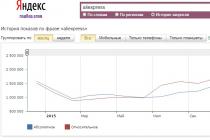Start working on the document on time to meet the deadline. Learn how to create a safe vacation schedule - 2020. Experts have compiled a complete guide to action.
In the article:
Download useful document:
Vacation schedule for 2020: who makes up and when
The vacation schedule is a mandatory document that is drawn up annually. It prescribes how the company's employees will rest in the next calendar year. Both employees and the employer are required to comply with the document. The latter needs to draw up a document with clearly defined dates.
A vacation schedule is needed to:
- Prepare a notice in advance, pay vacation pay and fulfill all other obligations in relation to the vacationer.
- Find a replacement for a specialist who goes on vacation in time.
- Prevent employees from accumulating unused vacation days The company may be fined for this.
- Distribute vacation days among work groups, teams and departments so that no department is idle due to the simultaneous absence of several employees.
Drawing up a vacation schedule for 2020 is entrusted to a personnel officer. Can be taken as a basis unified form No. T-7 , approved by the Decree of the State Statistics Committee of the Russian Federation No. 1 dated January 5, 2004. You can also develop your own document form by approving it with an order. The document is certified by the signature of the head personnel service and submitted for approval to the director of the company.
Attention! The GIT controls the deadlines for approving the document for 2020 and strictly monitors compliance with them. The deadline is December 17, which is Tuesday in 2019. You can play it safe and approve the 2020 document in advance. Consider duration working week in your organization.
Information to be included in the sample:
- Employer details.
- Information about the employee: structural unit, position or profession, personnel number, last name, first name and patronymic.
- Holiday start dates.
- Quantity calendar days holidays.
- Transfer data and notes indicating the reason for the transfer.
How to get rid of vacation debt for 2019
The personnel officer needs to calculate the vacation days that employees have accumulated over past periods of work in the company. The correct number of days that an employee is entitled to use in 2020 must be indicated in the vacation schedule, or a separate vacation debt repayment schedule should be drawn up.
Vacation repayment schedule
There are several ways to pay off vacation debts if the employee does not mind getting paid for them. monetary compensation, and you do not want to pull such debts for the next year. Each of them has its pros and cons.
Crib. How to get rid of accumulated vacation debts

Compilation procedure for 2020: step by step algorithm
Step 1. Find out the desires of employees
Who to include in the new schedule
Enter in the document template for 2020 all full-time employees, including external and internal part-timers. You may not reflect in the general list of maternity leavers who do not plan to return to work in the next calendar year. But those whose decree ends next year, make it right away.
Newcomers who have settled in the company after the approval of the document, leave for the first year is provided on the basis of applications, and not according to the schedule.
Check if there are beneficiaries in the team. They have the right to leave at any convenient time in accordance with the norms of the Labor Code.
If the company is large, authorize line managers to create preliminary draft schedules for each department, and then combine them into a master vacation schedule in Excel (a template can be downloaded online). Doing it quickly and without errors will help smart Excel spreadsheet from the experts of the magazine Personnel business. It will help you figure out the end dates of vacations, taking into account the holidays, warn who will start vacation in the near future and form unified form graphic arts.
Smart Vacation Schedule: Updated Version for 2020

Attention! Effective October 2018 new article 262.2 of the Labor Code of the Russian Federation, which gives employees with three or more children under the age of 12 the right to take annual paid leave at any convenient time.
Taking into account the opinions of employees will avoid grievances and conflicts when scheduling vacations. It is advisable to entrust the heads of departments to collect the wishes of subordinates. They will take into account the interchangeability of employees, seasonal workload. If the organization is small, then a personnel worker can collect the wishes of all employees.
Advice from the editors of the magazine "Kadrovoe delo"
Discuss with employees in advance the timing of the leave or request information in writing. For example, instruct department and work group heads to create preliminary schedules, and then consolidate them into one document. What you need for this, read the article:
Step 2: Make Preliminary Schedules
Often it is simply not possible to take into account the desire of all employees. In this case, we leave only the wishes of preferential categories unchanged. We give the rest the opportunity to independently agree on the time of the vacation.
Many employees want to go on vacation in the summer. To ensure this, you can plan holidays in parts. In this case, the employee will be indicated in the vacation schedule in two lines. In doing so, keep in mind:
- Written confirmation will be required that the employee agrees to the division of the vacation into parts.
- One part of the vacation must be 14 or more calendar days.
If the employees fail to agree, then the heads of departments can schedule a vacation for them at a time when it is convenient for the organization. By the way, some months can be made “closed for holidays” altogether. The employer has the right to do this if, due to the peculiarities of production, the absence of an employee during this period may adversely affect the normal course of the organization's work.
Step 3: Check Preview Charts
Heads of departments transfer pre-compiled schedules to the personnel service for verification. The personnel officer will check whether the vacation begins earlier than the period for which it is provided.
Step. 4. Design a vacation schedule
A project is a formalized but not yet signed or approved document. To reduce employee conflict over vacations, collect statements from them with wishes for when and for how long they plan to go on annual paid vacation next year. Make a draft vacation schedule - 2020. This way you will save your nerves and save time - you won’t have to explain to a forgetful employee why his vacation was scheduled for November, although he wanted to relax in the summer.
Crib. How to draft a vacation schedule
Step 5. Agree and approve the vacation schedule
The vacation schedule must be agreed with the trade union, but only if it is in the company. The draft document in the trade union committee must consider within 5 working days. Did not wait for a motivated opinion - you assert without consent.
You need to approve the vacation schedule 2 weeks before the next one calendar year. December 17 is the latest schedule approval date.
- The vacation schedule can be approved by the head of the organization. To do this, he puts the date and his signature in the upper right corner of the document.
- The vacation schedule can be approved if you issue an order for the company's core business and include the item "Approve the vacation schedule for 2020" in it. The vacation schedule itself will be an appendix to the order.
Attention! The law does not specify how the vacation schedule should be approved. The leader does this at his own discretion.
Before giving the vacation schedule for 2020 to the manager for signature, check if these errors are in your document.
Common scheduling mistakes

Experts advise to approve the document in the first way. Firstly, in the unified form T-7, a stamp of approval is provided personally by the head. Secondly, the period of storage of the vacation schedule is very short - only one year from the moment they expire, and it is not advisable to approve such documents with orders that are stored permanently.
The law does not require the seal of the organization to be put on the chart. This document is for internal use only.
Step 6. Familiarize employees with the vacation schedule
The Labor Code does not directly provide that employees need to be introduced to the vacation schedule against receipt. Article 123 of the Labor Code of the Russian Federation only says that it is necessary to notify the employee about the start of the vacation 2 weeks before it starts. But Rostrud (letter dated 08/01/2012 No. PG / 5883-6-1) believes that the vacation schedule is a local act of the organization, therefore the employer is obliged to acquaint employees with it under signature.
Expert response from the Kadra System
Do employees need to be aware of vacation schedules?
Nina Kovyazina, Deputy Director of the Department of the Ministry of Health of Russia, tells
There is no single answer to this question in the law. There are currently two opposing positions on this issue.
Amount of fines:
- For officials (accountant, personnel officer) - a warning or a fine of 1000-5000 rubles.
- For individual entrepreneurs - a fine of 1000-5000 rubles.
- For organizations - from 30,000 to 50,000 rubles.
- The same fines threaten those who did not approve the document at all.
Where to download a sample chart for 2020
An example of filling out a vacation schedule for 2020
Use a "smart" excel document to meet legal deadlines and avoid mistakes when working on a document. A ready-made template for printing is attached to the table - a unified form No. T-7 with all the necessary details. When compiling a document, try to take into account the wishes of employees and respect the rights of parents with many children and other beneficiaries who are allowed by the Labor Code of the Russian Federation to take vacations at any convenient time.
Some organizations do not draw up vacation schedules or draw them up formally. But this document is mandatory for both the employer and the employee. From the article you will learn how to correctly draw up, change, supplement the vacation schedule. Tip one: remember about the categories of workers who have the right to use annual leave at a convenient time for them.
The vacation schedule is a document that is mandatory for both the employer and the employee ( Art. 123 of the Labor Code of the Russian Federation). He is prepared must be by December, since it should be approved no later than two weeks before the start of the calendar year (part 1 Art. 123 of the Labor Code of the Russian Federation). For example, the vacation schedule for 2020 had to be approved no later than December 17, 2019. The schedule is approved by order of the head of the organization.
If there is a trade union in the organization, then the schedule should be approved taking into account its opinion.
To fully understand the calculations with employees, for example, how to correctly calculate and pay salaries, average earnings in different cases, benefits, pay for business trips, etc., I recommend taking the online course Kontur.Schools "". As a result of the training, you will also receive a certificate of professional development 136 ac. hours.
What to consider when scheduling vacations
Council the first. Remember that there are categories of employees who have the right to use annual leave at a convenient time for them. For example, such categories include employees under the age of 18 or part-time workers (persons working part-time are granted annual paid leave simultaneously with leave at their main place of work).
Tip two. When scheduling vacations, take into account the wishes of employees, while not forgetting the production process.
Tip three. To draw up a schedule, use the unified form No. T-7, approved. Decree of the State Statistics Committee of Russia dated 05.01.2004 No. 1, or develop the form of the form yourself.
The vacation schedule reflects not only the annual basic paid holidays, but also additional paid holidays and holidays not used in the current year, which were transferred to another year.
Council the fourth. Familiarize employees under signature with the approved vacation schedule, despite the fact that the Labor Code of the Russian Federation does not directly oblige you to do this. But otherwise it is difficult to require employees to comply with it. You can familiarize yourself in the following way: on the back of the schedule, employees put their signature. Some organizations start a special journal, which serves specifically to familiarize employees with all the local regulations of the organization and other internal documents of the organization.
Changing the vacation schedule
In practice, it is difficult to strictly follow the schedule. After all, there are cases when the employer not only can, but is obliged to postpone the employee's vacation for another period: for example, if he fell ill on annual paid leave.
Tip five. Information related to the postponement of vacation for another period, be sure to reflect in the schedule. If the organization uses the unified form No. T-7, then in column 8 of this form indicate on the basis of which document the employee's vacation is transferred. The basis may be the statement of the employee, in which he indicates his request to postpone the vacation. In turn, the date to which the vacation is postponed is reflected in column 9 of form No. T-7.
Tip six. If necessary, make changes to the schedule. The basis for making changes will be the consent to the recall received by the employer from the employee, as well as the recall order.
Not every employee can be recalled from vacation, even if the employee does not mind returning to work early. For example, labor law prohibits the recall of pregnant women from vacation. In general, recall is possible only with the consent of the employee.
Tip seven. Reflect in the schedule information about dividing the vacation into parts, if this possibility was not taken into account earlier when drawing up. An application received from an employee with a request to provide him with only part of the vacation, and an order to provide this part will serve as the basis for amending the vacation schedule.
Remember that when dividing a vacation into parts, one of such parts cannot be less than 14 calendar days.
Tip eight. Make changes to the schedule even if employees want to go on vacation at a different time from the schedule. In this case, the grounds will be the statement of the employee and the order for leave.
Tip nine. Supplement the vacation schedule with the column “I am aware of the changes”, in which employees will sign after making adjustments to this document. In addition, it is better to prescribe the deadline for submitting an application for the postponement of vacation in local regulations.
Tip ten. For newly hired employees, draw up an additional vacation schedule or provide vacation only on the basis of their application. How to proceed in this situation is at the discretion of the employer. The Labor Code does not oblige to make any additions to the already approved vacation schedule, but it does not prohibit supplementing the schedule with information about the vacations of new employees.
Lack of vacation schedule: responsibility
If non-compliance with the schedule does not worsen the situation of employees, then the employer will not bear any responsibility. For example, if employees go on vacation outside the schedule.
If, on the contrary, non-compliance with the schedule leads to a deterioration in the situation of employees, then the employer cannot avoid liability. For example, if an employer does not comply with the schedule and employees are not provided with annual paid leave for two consecutive years, then this is a direct violation of labor laws. In this case, the employer can be fined under Art. 5.27 of the Code of Administrative Offenses of the Russian Federation.
For the absence of a vacation schedule, the employer may be fined under Art. 5.27 of the Code of Administrative Offenses of the Russian Federation. In this case, the penalty is:
- for officials - from 1,000 to 5,000 rubles;
- for individual entrepreneurs - from 1,000 to 5,000 rubles;
- for a legal entity - from 30,000 to 50,000 rubles.
At repeated violation the amount of the fine increases.
Why you need a vacation schedule
Having a vacation schedule helps in the following cases:
- The employer will be able to pay vacation pay within the period specified by labor legislation. According to Art. 136 of the Labor Code of the Russian Federation, vacation pay should be paid no later than three days before the start of the vacation.
- The employer has the opportunity to find an employee who can perform his official duties during the vacation of an absent employee.
- The employer can clearly track the number of vacations used by employees, can see information about the transfer of unused vacations.
- The vacation schedule marks the dates of annual paid holidays, which will allow the employer not to take an application from employees about.
Systematize or update your knowledge, gain practical skills and find answers to your questions at the School of Accountancy. The courses are developed taking into account the professional standard "Accountant".
To display the form, you must enable JavaScript in your browser and refresh the page.
"Personnel issue", 2012, N 4
VACATION SCHEDULE
The priority of granting the main annual paid leave is determined by the vacation schedule (form T-7), approved by the Decree of the State Statistics Committee of Russia dated January 5, 2004 N 1. The vacation schedule is drawn up for the coming calendar year, approved by the employer, taking into account the opinion of the elected body of the primary trade union organization no later than 14 days before the calendar year.
When scheduling vacations, the following should be taken into account:
labor law;
The specifics of the organization's activities;
wishes of employees.
The vacation schedule consists of two parts: requisite and tabular.
The requisite part contains: the name of the organization, the OKPO code, the document number, the date of compilation, the calendar year for which the vacation schedule is drawn up.
The vacation schedule can be drawn up either only on the basis of the employee's application for vacation, or by consideration of the management, but taking into account the wishes of the employees. In any case, one should not forget that if the employee does not use his right to leave at a convenient time, or he does not apply and he is not granted leave at all, this will entail a violation of his constitutional right. The manager is responsible for observing the procedure for scheduling vacations and monitoring the timeliness of the use of annual holidays by employees.
In the event that an employee is hired after the approval of the vacation schedule, it is possible to grant leave on the basis of an issued order or on the basis of an annex approved to the schedule. Approval of additions and changes made to the vacation schedule, as a rule, is carried out in the same manner as the approval of the schedule itself - including taking into account the opinion of the elected body of the primary trade union organization.
The tabular part of the vacation schedule can be compiled both in alphabetical order and in the order of subordination. A variant of scheduling according to the order of planned vacation dates is possible. The column "Number of calendar days" indicates the total number of calendar days of annual paid leave granted to the employee, while summing up the main and additional holidays. By agreement of the parties, the leave can be divided into parts, one of which (any in order) cannot be less than 14 calendar days. When arranging the names of employees in the order of priority of the planned dates for the start of the vacation, dividing the vacation into parts and providing these parts in different months entails repeating the name of the employee in the schedule several times - according to the number of parts of the vacation provided.
How to make a vacation schedule and what
documents should be followed?
First of all, it is necessary to take into account the requirements of the Labor Code of the Russian Federation. When drawing up a vacation schedule, it is necessary to use the Decree of the State Statistics Committee of Russia dated January 5, 2004 N 1 "On approval of unified forms of primary accounting documentation for accounting for labor and its payment", which approved type form vacation schedule, as well as comments on its completion.
The vacation schedule is drawn up for employees of all structural divisions organizations for the calendar year by months. The vacation schedule is a summary schedule. When compiling it, the provisions of the current legislation of the Russian Federation, the specifics of the organization's activities and the wishes of employees are taken into account. It is important to note that the vacation schedule is mandatory for both the employer and the employee.
Not later than two weeks before the start of the vacation, the employee must be notified against signature of the time it starts. To do this, the employer is recommended to keep a journal in which employees are notified against signature of the start time of the vacation.
At the time of approval, columns 1 - 6 must be filled in the schedule, while column 4 "Personnel number" is filled in if employees of the organization are assigned personnel numbers. In the "Notes" column, the grounds for granting a longer vacation than 28 calendar days may be indicated.
At the planning stage, information is entered into the schedule in parts of columns 1 - 6.
When filling out the schedule, it should be borne in mind that the names of the positions of employees are entered in accordance with the approved staffing table.
When entering the planned vacation date, the employer should take into account the wishes of the employee about dividing the vacation into parts. Columns 7 to 10 are filled in as employees use vacations.
Please note that the actual vacation date is entered after its actual end. The basis document for sending on vacation is an order to grant leave to employees, as well as a notice or notification of the start of the employee's vacation (if the employer provides such a form of notification).
In case of postponement of vacation, columns 8 and 9 are filled in. Information in these columns is entered on the basis of the employee's application and the order to postpone the vacation.
Column 10 "Note" is filled in by the employee of the personnel service if the employee was not granted leave in the current year, if the employee was recalled from vacation and part of it is transferred to the next year, if the employee's vacation was extended, and in other cases.
Information in the specified column is entered in accordance with the issued supporting documents.
At the request of the employer, form N T-7 can be changed by entering additional details. Please note that the changes made must be formalized by the relevant organizational and distribution documents of the organization.
The vacation schedule becomes mandatory for the employee and the employer after its approval.
When should vacations be scheduled?
The vacation schedule is drawn up no later than two weeks before the start of the calendar year for which it is drawn up. Thus, the vacation schedule for 2012 must be drawn up and approved no later than December 17, 2011.
Should the vacation schedule be fixed by regulations?
First of all, fixing the vacation schedule with local regulations is necessary in order to prevent possible disputes. It could be an internal rule work schedule, which describes all the stages of scheduling vacations: from collecting the wishes of employees about vacation time to notifying the employee about the start of the next paid vacation.
The vacation schedule is drawn up by order of the head of the organization (or authorized person) with the application of the tabular form of the schedule approved by this order. In accordance with Art. 123 of the Labor Code of the Russian Federation, the vacation schedule is mandatory for both the employer and the employee.
Is it necessary when approving the vacation schedule
take into account the opinion of employees and in what form to do it?
The vacation schedule is approved for a year at least two weeks before the start of the calendar year.
The vacation schedule is approved taking into account the opinion of the elected body of the primary trade union organization (if there is one at the enterprise; if there is no trade union cell in the organization, the schedule does not need to be agreed).
In order to take into account the wishes of employees regarding the time of the next vacation, you can draw up a questionnaire in any form. It reflects the name and position of each employee, the start time of the vacation (or each part of the vacation), the date the questionnaire was filled out and the signature of the employee. Such a questionnaire will be a document confirming that the opinion of employees was taken into account when drawing up the vacation schedule.
In the event that the employee's opinion regarding the time of granting him vacation is not taken into account (for example, one of the parts of the vacation is included in the schedule not in the period indicated in the questionnaire), in order to avoid disputes, it is advisable to obtain written confirmation that the employee does not object to the rest period indicated for him in the vacation schedule.
Is it necessary to take into account the wishes of all employees
when scheduling vacations?
Employees under the age of 18 (Article 267 of the Labor Code of the Russian Federation);
Persons working part-time - they are granted annual paid leave simultaneously with leave for their main job (Article 286 of the Labor Code of the Russian Federation);
Heroes of Socialist Labor and full cavaliers of the Order of Labor Glory (Article 6 federal law dated January 9, 1997 N 5-FZ "On the provision of social guarantees to the Heroes of Socialist Labor and full holders of the Order of Labor Glory");
Heroes of the Soviet Union, Heroes Russian Federation and full cavaliers of the Order of Glory (Article 8 of the Law of the Russian Federation of January 15, 1993 N 4301-1 "On the status of Heroes of the Soviet Union, Heroes of the Russian Federation and full cavaliers of the Order of Glory");
War invalids (Article 14 of the Federal Law of January 12, 1995 N 5-FZ "On Veterans" (hereinafter - the Law on Veterans));
Participants of the Great Patriotic War (Article 15 of the Law on Veterans);
Combat veterans (Article 16 of the Veterans Act);
Military personnel who served in military units that were not part of the army in the period from June 22, 1941 to September 3, 1945 for at least six months, military personnel awarded orders or medals of the USSR for service in the specified period (Article 17 of the Law on Veterans);
Persons awarded the badge "Inhabitant of besieged Leningrad" (Article 18 of the Law on Veterans);
Persons who worked during the Great Patriotic War at the facilities air defense, the construction of defensive structures and other military facilities within the rear borders of the active fronts (Article 19 of the Law on Veterans);
Spouses of military personnel - they are granted leave at their request simultaneously with the vacation of military personnel (Article 11 of the Federal Law of May 27, 1998 N 76-ФЗ "On the Status of Military Personnel");
Citizens exposed to radiation as a result of nuclear tests at the Semipalatinsk test site (Article 2 of the Federal Law of January 10, 2002 N 2-FZ "On social guarantees citizens exposed to radiation as a result of nuclear tests at the Semipalatinsk test site");
Citizens exposed to radiation as a result of a disaster at Chernobyl nuclear power plant(Article 14 of the Law of the Russian Federation of May 15, 1991 N 1244-1 "On social protection citizens exposed to radiation as a result of the disaster at the Chernobyl nuclear power plant");
Persons awarded the badge "Honorary Donor of Russia" (Article 11 of the Law of the Russian Federation of June 9, 1993 N 5142-1 "On the donation of blood and its components");
Women with two or more children under the age of 12 (clause 3 of the Decree of the Central Committee of the CPSU, Council of Ministers of the USSR of January 22, 1981 N 235 "On measures to strengthen state assistance to families with children").
The opinion of the above persons must be taken into account when drawing up the vacation schedule. In addition, if a vacation period is already indicated in the schedule, the following categories of employees may require that they be granted vacation in a different period:
Husband while his wife is on maternity leave (Article 123 of the Labor Code of the Russian Federation);
An employee before maternity leave or immediately after it, or at the end of parental leave (Article 260 of the Labor Code of the Russian Federation);
A person working part-time goes on annual paid leave at his main place of work (Article 286 of the Labor Code of the Russian Federation);
An employee who is a parent (guardian, custodian) of a child under the age of 18 to accompany a minor child entering educational institutions middle or higher vocational education located in a different area.
Does the form of the vacation schedule depend
from the legal form of the enterprise?
The standard form of the T-7 vacation schedule was approved by the above Resolution of the State Statistics Committee of Russia dated January 5, 2004 N 1. This unified form is used by all organizations operating in the territory of the Russian Federation, regardless of the form of ownership.
Who should approve the vacation schedule at the enterprise?
The vacation schedule is signed by the head of the personnel service and approved by the head of the organization or a person authorized by him, taking into account the reasoned opinion of the elected trade union body (if there is one) of this organization on the order in which paid holidays are granted.
Can changes be made to the holiday schedule?
Labor legislation does not regulate the procedure for amending the vacation schedule. You can make any changes to the already approved schedule if new employees are hired or vacation is postponed by agreement of the employee and the employer. Based on this, the procedure for making changes should be similar to the procedure for approving the vacation schedule itself: an addition is drawn up in the T-7 form and approved in the prescribed manner.
Is it obligatory to make a vacation schedule in an institution?
According to Art. 123 of the Labor Code of the Russian Federation, the order of granting paid vacations is determined annually in accordance with the vacation schedule, with which the employee must be familiarized against signature. The vacation schedule is mandatory for both the employer and the employee.
Thus, its absence is a violation of labor legislation and it must be drawn up annually.
When drawing up a schedule, consider:
The norms of labor legislation, which oblige the employer to provide certain categories of employees with leave at any time convenient for them;
wishes of employees;
The need to ensure the smooth operation of the organization;
Motivated opinion of the trade union.
What threatens the employer with the absence of a vacation schedule
Or if it is made with violations?
In the event that the employer does not have a vacation schedule or it is drawn up with violations current rules, the employer may be held administratively liable under Art. 5.27 "Violation of the legislation on labor and labor protection" of the Code of Administrative Offenses of the Russian Federation. In this case, the employer bears an administrative penalty:
Officials - administrative penalty in the amount of 1000 to 5000 rubles;
Persons carrying out entrepreneurial activity without forming a legal entity - an administrative fine from 1000 to 5000 rubles. or administrative suspension of activities for up to 90 days;
Legal entities - an administrative fine from 30,000 to 50,000 rubles. or administrative suspension of activities for up to 90 days.
An employee with two children under the age of 12
can't decide on vacation. Can be on holiday schedule
put the time that is convenient for the organization?
Recall that the order in which annual leave is determined by the vacation schedule, which is approved by the employer, taking into account the opinion of the elected body of the primary trade union organization no later than two weeks before the start of the calendar year in the manner prescribed by Art. 372 of the Labor Code of the Russian Federation for the adoption of local regulations. The vacation schedule is mandatory for both the employer and the employee.
It is also worth noting that when drawing up the schedule, the employer must take into account that there are categories of personnel who are granted leave at their request at a convenient time for them. Such categories are provided for by the provisions of the Labor Code and other federal laws. At the same time, neither labor legislation nor other federal laws provide that an employee with two children under 12 years of age has the right to take leave at a time convenient only for her. But do not forget that the Decree of the Central Committee of the CPSU, the Council of Ministers of the USSR dated January 22, 1981 N 235 "On measures to strengthen state assistance to families with children" is still in force, according to which working women with two or more children under the age of 12 should be given the priority right to receive annual leave in the summer or other time convenient for them.
In this regard, the specified Decree is subject to application and an employee with two children under 12 years of age has the right to take leave at a time convenient for her.
Leave an employee on vacation according to the schedule
may adversely affect the performance of the organization.
Can an organization refuse to grant leave?
The employer has no right to refuse to grant leave. But along with this labor legislation, there are cases when the annual paid leave must be extended or postponed for another period determined by the employer, taking into account the wishes of the employee. It is allowed to postpone leave at the initiative of the employer only in exceptional cases, when the granting of leave to an employee in the current working year will adversely affect the normal course of the organization's work. This can be done only with the consent of the employee, and the leave must be used no later than 12 months after the end of the working year for which it is granted.
The employer only has the right to offer to postpone the vacation, explaining to the employee the situation in the institution. If the employee agrees, an appropriate order is issued, if not, then the employer pays him vacation pay and the employee goes to rest.
Should employees of the organization
be familiar with the vacation schedule?
The employer, in accordance with Art. 123 of the Labor Code of the Russian Federation is obliged to notify the employee about the start time of the vacation no later than two weeks before it starts. But to acquaint with the vacation schedule - such an obligation of the employer is not established by the labor legislation of the Russian Federation, and such a decision can be made within the organization. To implement it, you can add a column under the familiarization signature to the vacation schedule.
Should the organization take into account
when scheduling vacations, the presence of small children?
Let us remind you once again that the vacation schedule is drawn up taking into account the opinion of the elected trade union body of this organization no later than two weeks before the start of the calendar year. The legislation also provides for certain categories of employees who are entitled to annual paid leave at a time convenient for them (women before or immediately after maternity leave, employees under the age of eighteen, employees who have adopted a child (children) under the age of three months, etc.).
There are no women with children on this list. Therefore, the law does not oblige the employer to provide working mothers with leave at a convenient time for them.
The organization plans to reduce the number of employees.
One worker demands the right to leave earlier,
than determined by the vacation schedule.
Is the manager's refusal legal?
In the event that the employee leaves before the start of the vacation specified in the specified vacation schedule, his right to vacation is exercised in accordance with the provisions of Art. 127 of the Labor Code of the Russian Federation - through the payment of monetary compensation for unused vacation and (or) the provision of vacation in kind with subsequent dismissal.
It is possible that leave is granted simultaneously with dismissal on the basis of a written application from the employee and by decision of the employer. In this case, in work book the date of dismissal will be put down as the last day of vacation. The employer has the right to refuse to grant leave to the employee with subsequent dismissal, especially if the employee is dismissed for guilty actions (the employer must necessarily refuse to grant leave to the employee with subsequent dismissal).
In other words, it is the employer who decides whether to grant the resigning employee leave with subsequent dismissal or pay him monetary compensation for unused vacation. And by general rule the employee is not entitled to demand from the employer the provision of paid leave even during the period of notice of dismissal due to staff reduction. Only if such an obligation of the employer is enshrined in sectoral (tariff) agreements adopted by the organization, in a collective agreement, local regulations or directly in an employment contract with an employee, he has the right to demand leave during the appropriate period to look for a new job or for other reasons. In this regard, the organization must also take into account the provisions of these documents.
If the relevant documents provide for the right of the employee to use annual leave during the period of notice of dismissal, the leave must be granted to him for the full duration and without subsequent deductions for the unworked days of the leave provided in advance.
Should I schedule vacations?
individual entrepreneur?
An individual entrepreneur is authorized, as well as legal entities, to act as an employer. In this case, he is obliged to draw up and annually approve a schedule for the provision of regular paid holidays. This must also be done no later than 2 weeks before the calendar year, that is, for 2012, the schedule must be signed by the individual entrepreneur no later than December 17, 2011. An individual entrepreneur also accepts a unified form N T-7, approved by the Decree of the State Statistics Committee of Russia dated January 5, 2004 N 1.
How should you indicate
period of vacation in the vacation column?
Vacation schedule includes total duration annual paid leave, which depends on which category the employee belongs to and how long he has worked.
The vacation schedule indicates the total number of calendar days of vacation and the start date of the planned vacation. Some insurers, instead of a specific vacation start date, indicate the start month of the vacation, which can lead to disagreement with labor inspectorate and with employees of the organization.
It should be noted that it is not necessary to indicate the end date of the vacation in the schedule, since the availability of information about the start date of the vacation and the number of vacation days is sufficient to determine the end date of the vacation.
Vacation, in addition to the next basic and additional paid vacation, includes calendar days of vacation not used by the employee for the previous period. However, it should not be forgotten that, in accordance with Art. 124 of the Labor Code of the Russian Federation, annual paid leave must be used no later than 12 months after the end of the working year for which it is granted, that is, it is impossible to postpone vacation for two years in a row. Please note that the transfer of annual paid leave to employees under the age of 18 is prohibited.
When determining the duration of vacation for the next calendar year, the number of days used for the upcoming vacation should be deducted from the number of vacation days by agreement with the employer. Dividing the vacation into parts (two or more) is not mandatory and is made by agreement of the parties. At the same time, according to Art. 125 of the Labor Code of the Russian Federation, when dividing a vacation into parts, one of its parts must be at least 14 calendar days. In the case of dividing the vacation into parts, the schedule should reflect each part of the vacation on a separate line.
How to document a transfer
annual paid vacation?
Based on the provisions of Art. 123 of the Labor Code of the Russian Federation, the vacation schedule is mandatory for both the employer and the employee. According to this provision, the employer, having drawn up and approved the vacation schedule, assigns the employee the right to leave exactly in the period that is reflected in the schedule. For the employee, this means that the employer is obliged to provide him with leave exactly during the period indicated in the schedule. But, despite this, during the calendar year there may be objective reasons for postponing vacations. However, the obligation of the schedule for execution by the parties prohibits unilaterally changing the set vacation time. When agreeing on changes in the vacation time specified in the vacation schedule between the employee and the employer, the deviation from the provisions of Art. 123 of the Labor Code of the Russian Federation cannot be recognized as illegal, provided that it is properly executed.
In the event that the initiator of the change is the employee, his statement on the postponement of the vacation and the reasons that led to such a need, as well as the consent of the employer, is necessary.
Article 124 of the Labor Code of the Russian Federation establishes that the annual paid leave must be extended or postponed for another period determined by the employer, taking into account the wishes of the employee, in cases of temporary incapacity for work of the employee, the performance by the employee during the annual paid leave of state duties, if for this purpose the labor legislation provides for exemption from work, in other cases provided for by labor legislation, local regulations.
In addition, the employer, at the written request of the employee, is obliged to postpone the annual paid leave for another period agreed with the employee, in cases where:
The employee was not timely paid for the time of annual paid leave;
The employee was warned about the start time of this leave later than two weeks before it began.
If the employer is the initiator of the change, then the documents confirming the legitimacy of the employer's actions to deviate from the vacation schedule are orders (instructions) on postponing holidays, recalling employees from vacations, other orders (instructions), as well as the written consent of employees. The employer may take the initiative to postpone the leave in exceptional cases, when the granting of a leave to an employee in the current working year may adversely affect the normal course of the organization's work.
The execution of the above documents is the basis for making appropriate changes to the vacation schedule.
Do I need to make changes to my holiday schedule?
in case of dismissal of employees
or hiring new employees?
Labor legislation does not contain norms containing requirements for the inclusion of changes in the vacation schedule in connection with the admission of new employees. Such requirements may be established by a local regulatory act regulating the procedure for drawing up a vacation schedule. To plan activities and control the use of vacations, the employer can make changes to the vacation schedule by supplementing it with information about regular paid vacations for newly hired employees.
Is it necessary to include part-time workers in the vacation schedule?
As for the inclusion of part-time workers in the vacation schedule, the labor legislation does not contain these requirements. In our opinion, since the part-time worker performs a specific job, the employer's ignorance of the vacation time of the part-time employee can lead to inefficient vacation planning. Part-time workers are recommended to be included in the vacation schedule on the basis of their written application, which indicates the period of vacation. It should be borne in mind that persons working part-time are granted annual paid leave simultaneously with leave for their main job. If the employee has not worked for six months at a part-time job, then leave is granted in advance.
In addition, according to Art. 286 of the Labor Code of the Russian Federation, if at a part-time job the duration of the employee's annual paid leave is less than the duration of the leave at the main place of work, then the employer, at the request of the employee, grants him leave without saving wages appropriate duration.
Do I need to make changes to my holiday schedule?
when granting study leave to an employee?
The vacation schedule is drawn up and approved for annual basic and additional vacations. Study leave has nothing to do with them and is considered targeted. Taking advantage of study leave is the right, not the obligation of the employee, that is, if he has the opportunity to combine study with work, then he may not issue study leave. If this is not possible, then the employee must submit a call certificate and an application for leave. In this case, the employer does not have the right to refuse, since the procedure for granting study leave is regulated by Art. 173 of the Labor Code of the Russian Federation.
Thus, no changes in the vacation schedule related to the departure of employees on study leave need to be made.
T. Mezhueva
Journal Expert
Signed for print
- HR records management
Keywords:
1 -1
December 12, 2016 Accounting News, No. 45 (December 2016) The vacation schedule is one of the basic documents that form the basis personnel documentation any company, regardless of the form of ownership. Often, those responsible for maintaining personnel records do not attach due importance to such a local regulatory act as a vacation schedule. But it is mandatory for both the employer and the employee (part 2 of article 123 of the Labor Code of the Russian Federation). The purpose of its compilation is to streamline the provision of regular paid holidays and ensure that the required number of employees stay at work. There are also situations when employees do not want to go on vacation, and then what should the employer do? After all, failure to provide annual paid leave for two consecutive years is prohibited (part 4 of article 124 of the Labor Code of the Russian Federation). Thus, the way out of the situation when the employee does not want to go on the next paid vacation due to him is to draw up a vacation schedule. In turn, the absence or incorrect drawing up of a vacation schedule for the employer entails bringing the latter to administrative responsibility (Article 5.27 of the Code of Administrative Offenses) in the form of a fine - for officials in the amount of 1,000 to 5,000 rubles; on legal entities- from 30,000 to 50,000 rubles. In accordance with Art. 305 of the Labor Code of the Russian Federation, the mode of operation, including the procedure for granting annual paid holidays, is determined by agreement between the employer - an individual and the employee. Accordingly, the vacation schedule for this category of employers is not mandatory. However, when hired by an employer - an individual a large number it is advisable for employees to draw up a vacation schedule (Letter of Rostrud dated December 20, 2011 No. 3683-6-1).Holiday scheduling rules
The vacation schedule is drawn up by persons responsible for maintaining personnel records in the company. When compiling this document it is important to observe the principle of voluntariness (take into account the will of employees) when determining the timing of the next vacation for a special category of employees. It's about about those employees of the company who have the right to use it at any time convenient for them (part 4 of article 123 of the Labor Code of the Russian Federation). For example:- minors under the age of 18 (Article 267 of the Labor Code of the Russian Federation);
- part-time workers (leave is provided simultaneously with leave for the main job) (Article 286 of the Labor Code of the Russian Federation);
- employees whose spouses are military personnel (vacation is granted simultaneously with the spouse's vacation) (clause 11, article 11 of the Federal Law of May 27, 1998 No. 76-ФЗ “On the Status of Military Personnel”);
- women before maternity leave or immediately after it, as well as at the end of parental leave (Article 260 of the Labor Code of the Russian Federation);
- employees whose wives are on maternity leave, regardless of the time of their continuous work this employer(part 4 of article 123 of the Labor Code of the Russian Federation);
- employees who have adopted a child (children) under the age of three months (part 3 of article 122 of the Labor Code of the Russian Federation).
- Work experience. The right to paid annual leave when drawing up a vacation schedule arises for an employee if the work experience with this employer is at least six months. If the length of service is less than six months, the employee must be notified in writing.
In turn, if during the period for which regular leave is granted, the employee took additional leave without pay, the period of which is more than seven calendar days, or was on parental leave, then this time is not included in the length of service giving the right to paid annual leave. In the situations under consideration, it is allowed to postpone the time of annual paid leave by agreement of the parties. A number of employees are entitled to receive leave, regardless of the length of service. We are talking about underage workers, women before or after maternity leave, adoptive parents of children under the age of three months.
- Early leave. If the employee belongs to a preferential category, his vacation should be scheduled before the expiration of the employment contract. For example, granting leave to part-time workers.
- By agreement of the parties. In the event that by agreement of the parties to employment contract it is stipulated that the leave is granted to the employee before the expiration of six months of continuous work, then the leave for this employee must be included in the vacation schedule.
- The parties concluded a fixed-term employment contract valid for the current year. In the case under consideration, the employer has no reason to plan the employee's vacation for the next year, labor Relations with which they will end before its onset.
- Annual additional paid leave. In accordance with Art. 116 of the Labor Code of the Russian Federation, annual additional paid holidays are granted to employees employed in work with harmful and (or) dangerous working conditions, employees with a special nature of work, employees with irregular working hours, employees working in the Far North and equivalent areas, as well as in other cases provided for by the Labor Code of the Russian Federation and other federal laws (for example, civil servants, employees of internal affairs bodies, etc.).
- In the vacation schedule, it is necessary to take into account the benefits due to employees.
For example, the company conducted an attestation of workplaces, as a result of which it was found that certain positions fall under the class of working conditions according to the degree of harmfulness and danger of factors in the working environment and labor process with a value of at least three. Despite the results obtained, the employer did not include the prescribed 7 days of additional paid leave, as well as other benefits in connection with this, in the vacation schedule. The employee went to court, and the latter recognized his right to the provision of benefits stipulated by labor legislation. Thus, according to the decision of the Leningrad Regional Court dated 23.07.14 No. 33-3637 / 2014, the judges took into account the requirements of Decree of the Government of the Russian Federation dated 11.20.08 No. 870 and the legal position of the Plenum Supreme Court RF. Because the ongoing violation labor rights employees is that in fact the employer recognized the right of his employees to compensation and payments and even accrued them, but did not pay them without explaining the reasons, the court ordered the enterprise not only to issue appropriate orders and change the shift schedules of employees and paid holidays, but also to fully pay the employees all the compensations and other monetary payments due to them. Thus, when drawing up a vacation schedule for employees, the employer is obliged to take into account all the benefits due to employees based on the results of the certification passed.
- Must be included in the vacation schedule vacation not used by the employee in the current year and carried over to the next year.
- An employee who is on leave to care for a child up to 1.5 years old loses the right to receive paid leave even if he went to work part-time. This position is supported by the Federal Antimonopoly Service of the Volga-Vyatka District in its Decree No. A39-3748/2014 dated April 6, 2015. The essence of the dispute was that during the audit of the organization, FSS specialists revealed that several employees who were on parental leave and received the due social benefit actually continued to work in the organization on a part-time basis. These employees, in accordance with the vacation schedules, went on annual paid vacations. The company accrued and paid them the vacation pay due to them, based on their average monthly earnings. However, the inspectors considered that these payments violate labor laws, the requirements of Art. 260 of the Labor Code of the Russian Federation, according to which an annual paid leave can be granted to a woman at her request either immediately before the maternity leave, or immediately after the end of the parental leave, regardless of the length of service with this employer. The arbitrators pointed out that such a position is consistent with the opinion of the Supreme Court of the Russian Federation, set out in the Resolution of the Plenum of the Supreme Court dated January 28, 2014 No. 1 “On the application of legislation regulating the labor of women, persons with family responsibilities and minors.” An employee who is on leave to care for a child up to 1.5 years and at the same time receives a care allowance cannot go on the annual main paid leave, since the Labor Code of the Russian Federation does not provide for the possibility of using two or more leaves at the same time.
Length of annual paid leave
As a general rule, the duration of the annual basic paid leave is 28 calendar days (Article 115 of the Labor Code of the Russian Federation). Nevertheless, the Labor Code of the Russian Federation allows the provision certain categories employees of the annual basic paid leave lasting more than 28 days. These include:- employees under the age of 18 - 31 calendar days (Article 267 of the Labor Code of the Russian Federation);
- working disabled people (regardless of the disability group) - at least 30 calendar days (Article 23 of the Federal Law of November 24, 1995 No. 181-FZ "On the Social Protection of Disabled Persons in the Russian Federation");
- teaching staff- from 42 to 56 calendar days (Article 334 of the Labor Code of the Russian Federation, Decree of the Government of the Russian Federation dated May 14, 2015 No. 466 “On annual basic extended paid holidays”);
- state civil servants - 30 or 35 calendar days, depending on the position held (Article 46 of the Federal Law of July 27, 2004 No. 79-ФЗ “On State civil service Russian Federation");
- judges - 30 working days (part 2 of article 19 of the Law of the Russian Federation dated 06/26/92 No. 3132-1 "On the status of judges in the Russian Federation");
- municipal employees - 30 calendar days (part 3 of article 21 of the Federal Law of 02.03.07 No. municipal service in the Russian Federation"), etc.
- Determine the number of vacation days that should be planned in the schedule for the next year for each employee. To do this, determine the end date of the year that the employee worked (that is, the date on which the next year expires from the date the employee was hired). For example, if an employee was hired on October 15, 2016, then the end date of the year that the employee worked would be October 14 of each subsequent year.
- Draw up a vacation schedule for each employee in such a way that, as of the end date of the year worked, he does not have unused vacations (Article 122 of the Labor Code of the Russian Federation). Note that the current legislation does not prohibit the provision of holidays "in advance", that is, for unworked time. In this situation, it is necessary to build on the fact that for each working year the employee uses at least vacation days than he is supposed to.
- Until December 17 of each year, it is necessary to draw up and approve a vacation schedule with the head of the company (employer). To do this, you can use the unified form of the vacation schedule No. T-7 (approved by the Decree of the State Statistics Committee of Russia dated 05.01.04 No. 1 “On approval of unified forms of primary accounting documentation for accounting for labor and its payment”). Note that the vacation schedule can also be drawn up in any form, however, subject to its approval by the head of the company as a form of the primary document.
- To familiarize all employees with the vacation schedule personally against signature. To do this, in the unified form No. T-7, you can provide a separate column or put into practice familiarization with the vacation schedule by compiling a separate statement or other document (a log book for familiarizing yourself with vacation schedules). If subsequently the term for granting leave is changed at the request of the employee, it is necessary to make a corresponding note in columns 8–9 of the schedule of Form No. T-7. This mark is affixed on the basis of the order to postpone the vacation.
- Not later than two weeks before the start of the vacation, give the employee a notice of the start of the vacation against signature (part 3 of article 123 of the Labor Code of the Russian Federation, Letter of Rostrud dated 07/30/14 No. 1693-6-1). Other options for notifying employees are also possible, for example, by means of a visa to familiarize the employee on a vacation order (Letter of Rostrud dated 03/22/12 No. 428-6-1).
- Issue an order to grant leave to an employee (form No. T-6). In a situation where an employee goes on vacation in accordance with the vacation schedule, that is, on time, he is not required to receive an application for vacation.
- The time spent by the employee on annual paid leave must be reflected in the time sheet (unified form No. T-12 or No. T-13) with the letter code "OT" or the digital code "09".
- Information about the annual paid leave provided (used) to the employee must be reflected in section VIII of the employee's personal card (unified form No. T-2).
Making changes to the vacation schedule
Since the vacation schedule is a planning document, when the year for which this local normative act is valid, the following situations may arise that require adjustment. These include the following cases: 1. Hiring a new employee. Because the this question is not regulated at the legislative level, then in practice the following options for adjusting the current vacation schedule are applied:- An application is made to the current vacation schedule. The form of the application depends on what form of vacation schedule is used in the company - unified No. T-7 or arbitrary (preliminarily approved as primary personnel document employer). The specified application must be agreed with the trade union (if it exists in the company, part 1 of article 123, article 372 of the Labor Code of the Russian Federation), approved by the head of the organization.
- No changes (additions) are made to the current vacation schedule approved before the new employee is hired. Again hired employee it is necessary to send an application to the employer in which to indicate the intention to exercise the right to paid leave. When the employee and the employer agree on the start date and duration of the vacation, the latter issues an order to grant the vacation and draws up a note-calculation. Accordingly, information about the leave granted is entered into the employee's personal card.
Vacation schedule - an internal document that fixes the sequence of granting annual vacations to employees of the enterprise. Part 2 Art. 123 of the Labor Code of the Russian Federation defines the vacation schedule as a mandatory local act for both the enterprise and the employee. The only exception is employers individuals. If such an employer has few employees, then the procedure for granting and the date of going on vacation are determined by agreement of the parties. At in large numbers working it is desirable to approve the schedule. In addition to the Labor Code, Rostrud's letters explain whether it is necessary to draw up a vacation schedule.
What is a vacation schedule?
The need for a document is obvious. The schedule allows the employer to solve a number of organizational issues:
- exercise control over the timely provision of leave to employees and prevent unused periods from accumulating;
- pre-arrange vacation and timely accrue vacation pay. According to part 9 of article 136 of the Labor Code, money must be transferred 3 days before going on vacation;
- find a replacement vacationer to ensure smooth operation.
Holiday scheduling helps employees organize their holidays in advance.
Since the vacation schedule is considered a mandatory document, it may be required when checking the organization by the Federal Labor Inspectorate. If the company does not provide it, then in accordance with Art. 5.27 of the Code of Administrative Offenses, a fine of 30,000 to 50,000 rubles may be levied. from the enterprise, and official, or individual entrepreneur from 1000 to 5000 rubles.
The Labor Code does not provide for penalties for violation of the vacation schedule. If the employer refuses to let the employee go on vacation according to the approved schedule, Art. 5.27 of the Code of Administrative Offenses introduced administrative responsibility.
Note: the employer has the right to offer the employee to postpone the vacation if there is by necessity. If the employee refuses, leave must be provided in accordance with the schedule.
The dates when the vacation schedule should be drawn up are fixed in labor law. It also establishes the information to be included in the document:
- List of employees. Lists all employees with whom an employment contract has been concluded.
- Vacation duration. All days of rest due to the worker are indicated (the totality of annual paid, additional paid rest).
- Release date:
- specific day and month;
- only a month (then the employee draws up an application for a specific day of that month).
- Vacation section. It is indicated whether the employee's vacation will be divided (the minimum duration of one of the parts is 14 days).
The document should include employees working only under an employment contract. Persons with whom civil contract, annual paid leave is not required, therefore, they are not included in the schedule.
The absence of one of the sections is the basis for recognizing the vacation schedule as an invalid document.
So, the distribution of vacations by Labor Code and their documentary fixation is made in the vacation schedule. The legislation establishes the content of the document and the procedure for its adoption.
How to make a schedule
The rules for scheduling vacations that must be observed are provided for by Art. 123 TK
- The document must be approved before the new year no later than 2 weeks.
- When compiling preliminary schedule take into account the personal desire of the employee, and the right of some employees to choose a time of rest that is convenient for them.
- The employee must be notified of the start of the vacation against receipt 2 weeks in advance. How to notify him, the personnel department determines independently. These can be special statements, notices, familiarization sheets. It will be convenient to enter separate columns in the form, where the employee can put the appropriate marks.
- If the enterprise has a trade union, the final version must be agreed with it.
The video discusses the rules for scheduling vacations for next year
Otherwise, when planning vacations for employees and scheduling vacations, take into account the features production cycle at the enterprise. If the organization has many departments or divisions, then first each of them draws up its own draft document, then the personnel department creates a consolidated schedule, taking into account the even distribution of vacation periods throughout the year.
Annual leave and additional leave, if entitled, are entered into the schedule. Unused vacation for previous periods, you can add to the schedule for the next year or provide it in agreement with the employee.
According to Art. 115 of the Labor Code paid annual leave is 28 working days. Some groups of employees have longer holidays. These are civil servants, teachers, workers under the age of 18, people with disabilities. Some employees are entitled to additional leave. These are people who work in hazardous industries - in the Far North, who have irregular working hours.
By agreement with the employee, it is permissible to break the vacation into parts. For more information on the division of annual paid leave into parts, follow the link.
Note: in accordance with Art. 125 of the Labor Code, when dividing a vacation, one part of it must be at least 14 calendar days.
When drawing up a document, it must be taken into account that there are categories of persons to whom the enterprise is obliged to provide leave at a time convenient for them, namely:
Additionally
The vacation schedule does not include maternity leave, as well as parental leave. In addition, a pregnant employee has the right to write an application with a request to provide her with annual paid leave at a convenient time for her, despite the approved schedule. Moreover, the employer has no right to refuse her. The article has more detailed information about going on vacation before or after the decree.
- employees under 18;
- honorary donors;
- raising a disabled child under the age of 18;
- having two or more children under the age of 12;
- recalled from annual leave;
- external collaborators.
Such employees can optionally change the already scheduled vacation date, for this he needs to write an application. The employer has no right to refuse.
If the employee started working at the enterprise when the schedule has already been approved, he goes on vacation on the basis of an order. In this case, the employee can not be included in the vacation schedule.
How to fill out the vacation schedule form
The enterprise can apply the unified form No. T-7 or approve an independently developed schedule, taking into account the provisions of Law 402-FZ "On Accounting", which relate to mandatory details in the primary document.
Before signing the final version of the schedule with the manager, it is necessary to fill in columns 1-6. They indicate the following information:
- The department in which the employee is located.
- His position is on the staff list.
- Full Name.
- Number on the board.
- The total number of vacation days, including extra and unused. If the vacation is divided into parts, this is reflected in a separate line.
- Start date.
In this form, the document is sent for approval to the head of the enterprise. After signing with the schedule, you need to familiarize all employees against signature. For this, as already mentioned, you can provide special columns or draw up a separate document.
On the features of compiling and filling out a vacation schedule, see the following video
The remaining columns in the document are filled out during the year. They fix:
- actual date of departure;
- at or within the current year - details of the order on the basis of which it was transferred;
- the expected date of the transfer;
- additional information: the reason for the transfer or recall from vacation, etc.
The original document must be kept by the Human Resources Department for one year.
How to make changes to the schedule
Changes to the document need to be made in two cases:
- When vacation is postponed by agreement with the employee. This information is entered in columns 8-9.
- When an employee was recalled from vacation (you can learn more about recalling an employee from annual leave). The information is displayed as follows: in column 10 - a note on the recall and the date the vacation was terminated, in column 8 - the details of the recall document, in 9 - the start date of the rest of the vacation.

Common mistakes
Sometimes in the process of scheduling vacations they allow typical mistakes which the inspection authorities may regard as a violation of labor legislation and impose penalties. The most common miscalculations are:
- Violation of the deadline for signing the schedule (less than 2 weeks before the new year).
- Drawing up a document without taking into account the wishes of employees, non-compliance priority right employee to choose a vacation time convenient for him.
- Failure to comply with the required number of days provided when dividing the vacation into parts.
- Lack of documents or marks stating that the employee is familiar with the schedule.
Thus, when drawing up a vacation schedule, one should take into account all the provisions of the Labor Code of the Russian Federation and the features production activities so that the work process is continuous, and the right of employees to rest is not violated.
To learn more about scheduling vacations - ask questions in the comments to the article.














